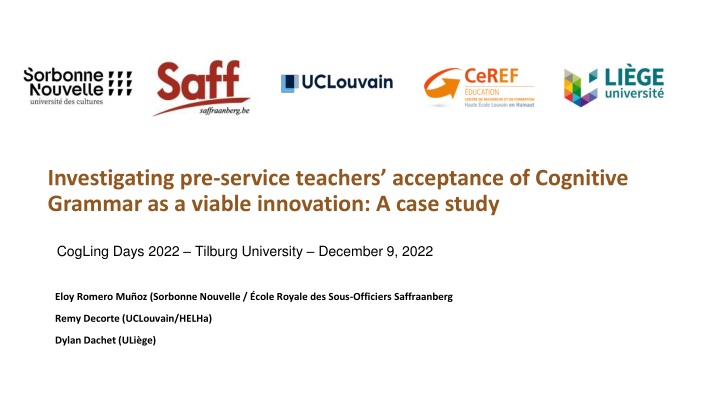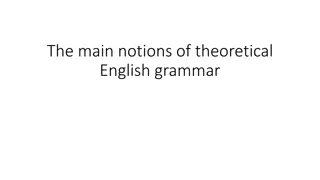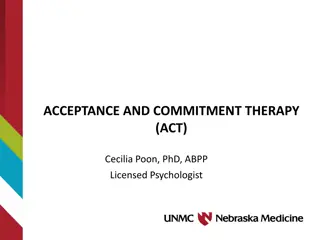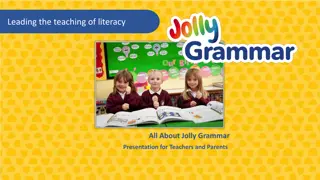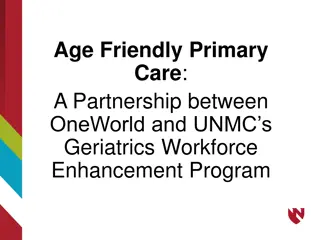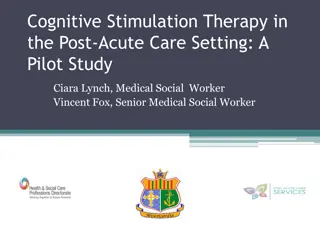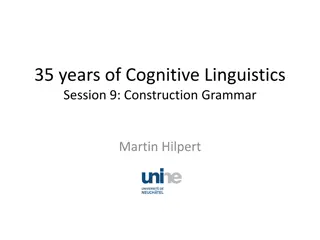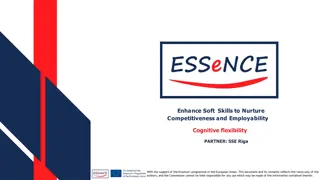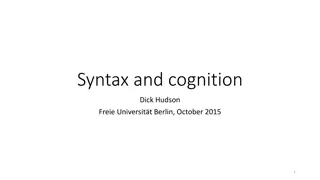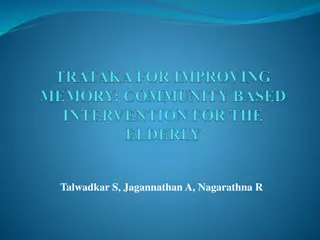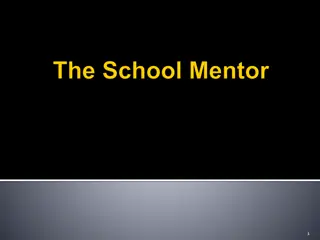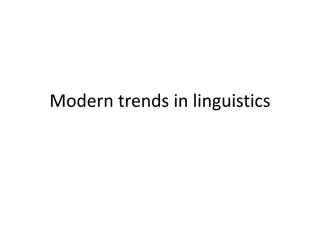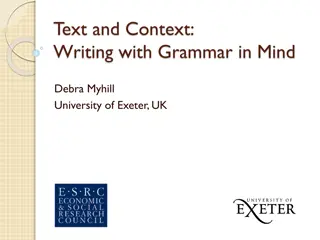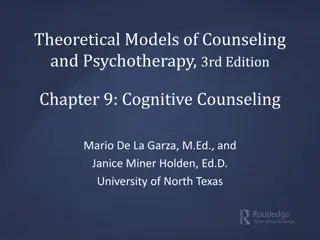Investigating Pre-Service Teachers' Acceptance of Cognitive Grammar
This case study explores pre-service teachers' attitudes towards Cognitive Grammar as an innovative approach in language acquisition and teaching. Grounded in Applied Cognitive Linguistics, the study delves into the meaningfulness of grammar and potential challenges in its implementation. By addressing research gaps and targeting specific grammatical structures, the study aims to shed light on the acceptance and efficacy of Cognitive Grammar among educators.
Download Presentation

Please find below an Image/Link to download the presentation.
The content on the website is provided AS IS for your information and personal use only. It may not be sold, licensed, or shared on other websites without obtaining consent from the author.If you encounter any issues during the download, it is possible that the publisher has removed the file from their server.
You are allowed to download the files provided on this website for personal or commercial use, subject to the condition that they are used lawfully. All files are the property of their respective owners.
The content on the website is provided AS IS for your information and personal use only. It may not be sold, licensed, or shared on other websites without obtaining consent from the author.
E N D
Presentation Transcript
Investigating pre-service teachers acceptance of Cognitive Grammar as a viable innovation: A case study CogLing Days 2022 Tilburg University December 9, 2022 Eloy Romero Mu oz (Sorbonne Nouvelle / cole Royale des Sous-Officiers Saffraanberg Remy Decorte (UCLouvain/HELHa) Dylan Dachet (ULi ge)
Outline BACKGROUND RESEARCH QUESTIONS METHOD FINDINGS DISCUSSION SCOPE AND LIMITATIONS CONCLUSION
Background Background
Preliminary considerations This study is grounded in Applied Cognitive Linguistics, more specifically in Cognitive Grammar. CG views grammar as inherently meaningful and furthers an approach to language acquisition and teaching that stresses such meaningfulness (see especially Achard, 2008).
Preliminary considerations (2) This study stems from a few observations in the literature that show that ACG does not necessarily practice (pardon the pun) what it preaches More and better use of actual usage (see Gilquin, 2022a, 2022b); More interventions that facilitate uptake via embodied experience / learning (rather than abstract schematic representations) (see Wirag, personal communication; Romero Mu oz & Decorte, under review). More impact in the FL classroom (Romero Mu oz, 2022; Romero Mu oz & Decorte, under review) nor does it meet some of the sine qua nons of SLA research Methodological consolidation (Wirag, 2022). and Innovation research. A more ecological approach is needed (Markee, 1997).
Research gap We noted that: Understanding teacher beliefs about grammar and grammar teaching is a prerequisite to any attempt at implementing any kind of findings from SLA research (Phipps & Borg, 2009), which has not been the case in ACL research (Romero Mu oz, 2022; Romero Mu oz & Decorte, under review). Our study is premised on the hypothesis that: Pre-service education may constitute a window of opportunity (Busch, 2010).
Targeting a grammatical structure Wedell (2009): we should adopt an ecological perspective to innovation as opposed to blind applicationism which is defined as the use of whatever pedagogical innovation is trending in academia (Romero Mu oz, 2022, p. 269). 2 criteria: Pertinence (not some abstruse grammatical phenomenon) Something that could facilitate rather than complexify learning using C The Count/Mass Distinction (CMD) seemed to check all the boxes
The CMD Following up on Dro d (2017), we believe that CG could offer a more realistic set of principles than what is available in the so- called canon of ELT grammar (O Keeffe & Mark, 2017). A fundamental concept in ELT > relevant to the participants However appealing in their own right, be it only because they allow discrete-item teaching and testing (Ellis, 1997, p. 639), such axiomatic rules la Murphy may create more problems than they actually solve by furthering categories that are impressionistic rather than cognitively pertinent (Romero Mu oz, 2012, 2022). ELT canon deals with surface phenomena associated with the CMD such as plurals and quantifiers - the CMD is viewed through its manifestations, not in its own conceptual right.
Research question Research question
Research question Which conditions are perceived by pre-service language teachers as affecting their acceptance of a CG-informed approach to the instruction of the CMD?
Method Method
Method The present article reports on data that was gathered through focus groups and analyzed using thematic analysis (Braun & Clarke, 2006). Questioning route: Based on the Technology Acceptance Model (TAM; Venkatesh & Davis, 1996; alternative use, Decorte et al., in preparation). TAM: Innovation is largely dependent on the users perceptions and beliefs about said innovation. Two key variables: perceived usefulness (PU) and perceived ease of use (PEOU). Together, these variables influence the participant s behavioral intention (BI).
Findings Findings
Findings Our thematic analysis identified three macro categories characterizing various conditions underlying the participants acceptance or refusal of the innovation presented to them: Prior knowledge and experience Ecological validity Teacher appropriation These macro categories will be presented now with a selection of illustrative verbatims.
Prior knowledge and experience apprenticeship of observation (Lortie, 1975) the necessity to adopt a contrastive approach with their first language, i.e. French. the belief that grammar is inherently complex >< anti-apprenticeship of observation (Moodie, 2016) the idea that rules/lists are not efficient The comparative when describing the innovation: much simpler (LJ FG1 / A FG2), more logical (L FG1), more helpful (F FG2) or more concrete (E FG2).
Prior knowledge and experience (2) anti-apprenticeship of observation (Moodie, 2016) They consistently use negative words to refer to grammar, which they describe as complex (J FG1), heavy (L FG1), fuzzy (LF FG1), horrible (A FG2), or abstract (E FG2) to name but a few of the qualifiers they use. In one instance: grammar teaching as a form of punishment (E FG2) (// see Romero Mu oz, 2012)
Prior knowledge and experience (3) L1 as facilitating or impeding L2 learning - unclear Here, our data reveals an interesting tension. On the one hand, these differences = possible obstacles for successful appropriation: And I think, yes, maybe it's because in some books, the English grammar is explained, the English grammar is explained the way we see things in French. So that's why it does, in the end it generates exceptions. But, in the end, they are not exceptions. (LF FG1) On the other hand, typological differences = opportunities for conceptual contrastive analysis (Danesi, 2003): Also in French somewhere, as you were saying, we do say de l argent , I think that it is necessary to make more also comparisons between the languages. (T FG2)
Ecological validity The participants also underscore the usefulness of the explanations used in the proposed innovation: Well I think, we were never given those terms, so bounded and unbounded, and I think that could have helped us all. And I think that if it helps us, it can clearly help us to create the lesson and to give the lesson to the students because we see a link, and so it's easier. (G FG1 ) However, the new terminology requires some contextualization. May not be suitable for autonomous use: But with the, how can I say, the way you explained them to us, it's fine, but if you had just given them to us like that, uh, it wouldn't have worked for me. I wouldn't have had anything to relate to. (E FG2)
Teacher appropriation Positive assessment YET assessment also appeared to be conditional upon participants perceived self-efficacy // Bandura (1994): people's beliefs about their capabilities to produce designated levels of performance that exercise influence over events that affect their lives (71). [...] Then, well, you gave us this example, I don't have any other idea, but I hope we will have some. (T FG2) But I totally agree with the idea too. But I don't really see how we could do it any other way [...](L FG1)
Discussion Discussion
Discussion The participants epistemological beliefs and perception of practice can be traced back to two primary metaphors: UNDERSTANDING IS SEEING THINKING IS PERCEIVING (Lakoff & Johnson, 1980) (Lakoff & Johnson, 1999). The metaphors they resort to when describing the proposed innovation are consonant with a CG approach. // importance of beliefs in acceptance of rejections of innovation > fertile ground for CG
Discussion (2) Congruence between the surveyed participants beliefs about language teaching and their assessment of a cognitive-pedagogical approach. YET: Necessity to provide a clear framework for implementation. Research gap in the literature review. The participants showed little confidence in their ability to appropriate the innovation // consonant with findings from Innovation Research (see especially Markee, 1997) !!! professional inexperience may also explain such reservations // [t]eachers with higher self-efficacy exhibit higher levels of innovative behavior (Hsi-Chi et al., 2011, p. 236).
Scope and limitations Scope and limitations
Scope and limitations Scope limited to one specific feature of the English language tested in an equally specific context. DO NOT draw overarching conclusions (// Wirag et al., 2022). Exploratory study: better understand a problem rather than offer conclusive evidence. To the best of the authors knowledge, this has never been done before in ACL research.
Scope and limitations (2) Focus on intentions and attitudes: difference between teachers espoused theories, i.e. what teachers claim they will do, and their theories-in-use, i.e. what teachers actually do in class (Argyris & Sch n, 1974; see also Basturkmen, 2012). Need for classroom observations to confirm reported intention
Scope and limitations (3) The present study focuses on pre-service teachers perceptions of an innovation based on CG. >< Tomlinson & Masuhara (2021): whilst teacher procedures and techniques are important, what really matters is the quality of learning that is facilitated (5). The study design does not allow us to draw conclusions in terms of learning gains. A follow-up study involving secondary school learners is necessary. From a language teaching perspective, CG is little more than another theoretical construct without evidence of its facilitative potential in the classroom.
Conclusion Conclusion
Implications for researchers within ACL The acceptance or rejection of said innovation appears to be conditioned by a pre-service teacher's prior knowledge and experience, the innovation s ecological validity, and the pre- service teacher s appropriation of said innovation. Are teachers on board? Is your innovation classroom-proof and ready to use? Are teachers able to appropriate it and how? Pre-service education may constitute a window of opportunity for the popularization of novel ideas in pedagogical grammar as anticipated by previous research. Get preservice teachers to experiment with the innovation iso doing the teaching / experimenting yourself
Back to square one // Initial hypothesis: further research into the applicability of CG needs to acknowledge and explore pre-service teachers beliefs about grammar and grammar teaching. Understanding teachers epistemological beliefs is a prerequisite to any attempt at implementing research findings.
THANK YOU FOR YOUR THANK YOU FOR YOUR ATTENTION! ATTENTION! Questions? Questions?
References References
References (abridged) References (abridged) Achard, M. (2008). Teaching construal: Cognitive Pedagogical grammar. Handbook of Cognitive Linguistics and Second Language Acquisition, 442 465. https://doi.org/10.4324/9780203938560-26 Argyris, C., & Schon, D. (1974). Theory in practice: Increasing professional effectiveness. Jossey-Bass. Basturkmen, H. (2012). Review of research into the correspondence between language teachers stated beliefs and practices. System, 40(2), 282 295. https://doi.org/10.1016/j.system.2012.05.001 Borg, S. (2019). Language Teacher Cognition: Perspectives and Debates. In X. Gao (Ed.), Second Handbook of English Language Teaching (pp. 1-23). Springer International Publishing. Braun, V., & Clarke, V. (2006). Using thematic analysis in psychology. Qualitative Research in Psychology, 3(2), 77 101. https://doi.org/10.1191/1478088706qp063oa Busch, D. (2010). Pre-service teacher beliefs about language learning: The second language acquisition course as an agent for change. Language Teaching Research, 14(3), 318 337. doi:10.1177/1362168810365239 Decorte, R. (in preparation). Collaborative action research and its effects on language teachers practices: a focus on metacognitive strategies. Dro d , G. (2017). The puzzle of (un)countability in English : a study in cognitive grammar. Wydawnictwo Uniwersytetu l skiego. Ellis, R. (1997). SLA research and language teaching. Oxford University Press. Gilquin, G. (2022a). Cognitive corpus linguistics and pedagogy: From rationale to applications. Pedagogical Linguistics, 3(2), 109-142. Gilquin, G. (2022b). Reflections on applied cognitive corpus linguistics. Pedagogical Linguistics, 3(2), 194-201. Le Foll, E. (2017). Textbook English: A Corpus-based Analysis of Language Use in EFL Textbooks. (2017, July). researchgate.net. https://www.researchgate.net/publication/326894033_Textbook_English_A_Corpus- based_Analysis_of_Language_Use_in_EFL_Textbooks Hsi-Chi, H., Jen-Chia, C., Ya-Ling, T., & Su-Chang, C. (2011). The influence of teachers self-efficacy on innovative work behavior - IPEDR. ipeder.com. Retrieved June 9, 2022, from http://ipedr.com/vol5/no1/50-H00112.pdf
References (2) References (2) Kang, E. Y., Sok, S., & Han, Z. (2019). Thirty-five years of ISLA on form-focused instruction: A meta-analysis. Language Teaching Research, 23(4), 428 453. https://doi.org/10.1177/1362168818776671 Karavas-Doukas, E. (1996). Using attitude scales to investigate teachers' attitudes to the communicative approach. ELT Journal, 50(3), 187 198. https://doi.org/10.1093/elt/50.3.187 Lakoff, G. and Johnson, M. (1980). Metaphors we live by. University of Chicago Press. Lakoff, G., & Johnson, M. (1999). Philosophy in the flesh: The embodied mind and its challenge to western thought. Basic books. Langacker, R. W. (2008). Cognitive Grammar: A Basic Introduction. Oxford University Press. Lortie, D. (1975). Schoolteacher: A Sociological Study. University of Chicago Press. Markee, N. (1997). Managing Curricular Innovation. Cambridge University Press Moodie, I. (2016). The anti-apprenticeship of observation: How negative prior language learning experience influences English language teachers beliefs and practices. System, 60, 29-41. https://doi.org/10.1016/j.system.2016.05.011. Murphy, R. (2016). Essential grammar in use (4th edition). Cambridge University Press. O Keeffe, A., & Mark, G. (2017). The English grammar profile of learner competence. International Journal of Corpus Linguistics, 22 (4), 457-489. Romero Mu oz, E. (2011). Il faut en finir avec l enseignement des langues. Presses Universitaires de Namur. Romero Mu oz, E. (2022). Teaching Form in the Action-Oriented Classroom: Can-Do!. In: McCallum, L. (eds) English Language Teaching. English Language Teaching: Theory, Research and Pedagogy (pp 257 273). Springer. https://doi.org/10.1007/978- 981-19-2152-0_15 Venkatesh, V. & Davis, F. D. (1996). A Model of the Antecedents of Perceived Ease of Use: Development and Test. Decision sciences, 27(3), 451-481 Wedell, M. (2009). Planning for educational change: Putting people and their contexts first. Continuum. Wirag, A. Li, Y., & Zhang, B. (2022). Applying Cognitive Linguistics to Foreign Language Teaching and Learning: Addressing Current Research Challenges. Cognitive Linguistic Studies, 9(2), 185-201.
